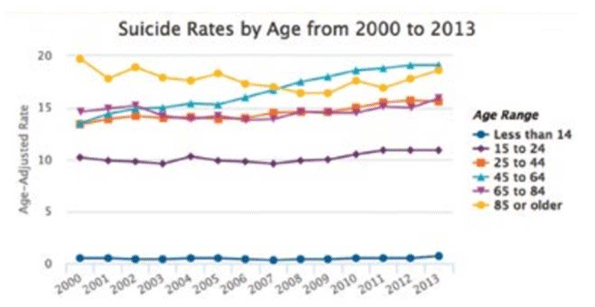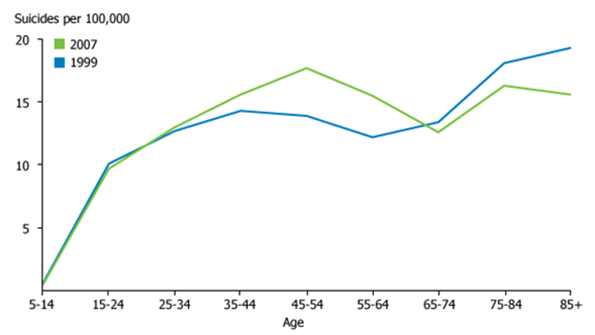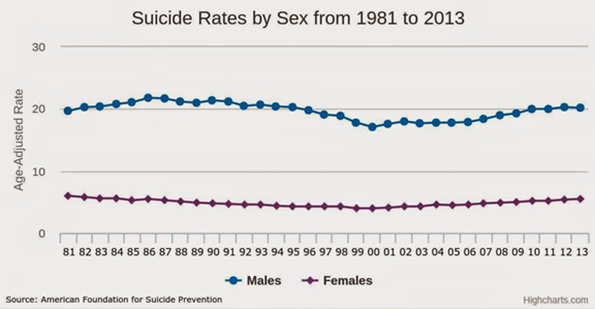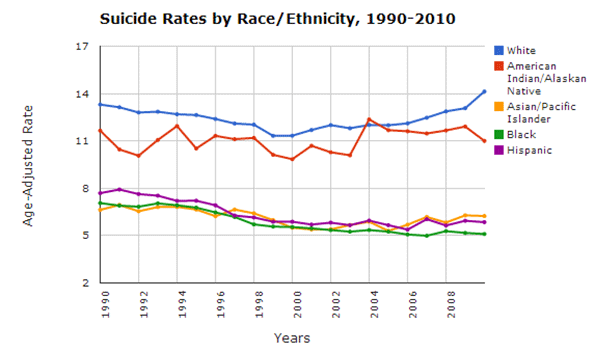
We often associate suicide with the crises of youth, or the despair of the old. Yet the group that is now experiencing the biggest surge in suicide is in the Baby Boomer Generation; from about 14 percent in the year 2000 to about 19 percent in 2013. Baby boomers rose to 37.5% of all suicides in 2010. That is now the highest suicide rate of any existing age bracket (shown in figure 1). In order to find a way to reduce this percentage, one must understand why this is happening in the first place.
Before tackling the issue of suicide, it is important to understand what it means to be a baby boomer. Baby boomers were those born in the United States between the years 1945 and 1964. Total births per year during that period “grew from 2.3 million to 4.3 million and then fell to 3.2 million.” This surge in births was largely due to the rapid expansion of the job market created by World War II. The subsequent financial comfort produced an overall positive attitude towards childbearing, causing what is known as the baby boom. These baby boomers would live to see a time where women were joining the work force in large numbers, automobiles were becoming popular, and the U.S. was in a war with Vietnam.
So why would people born in such an exciting time be committing more suicide today? A study done by Katherine A. Hempstead and Julie A. Phillips tries to decipher whether this sharp increase in Boomer suicide rate is due to personal (e.g. mental and physical health), interpersonal (e.g. divorce), or external circumstances (e.g. economic and political). The data for this study was collected from the National Violent Death Reporting System (NVDRS) and from the CDC. In 2010, suicides from personal circumstances decreased to 79.8%, interpersonal circumstances decreased to 40.4%, and external circumstances increased to 37.5% issue lies in the 4.6% increase in suicides due to external circumstances. This pattern suggests that the large increase in suicides among this generation due to changes in their external circumstances.

Figure 1: Suicide rates of different age brackets from 2000 to 2013 (afsp)
Most reports of suicide due to external circumstances were related to job, financial, or legal distress. A possible explanation of this reporting is the correlation between these suicides and the effects of the Great Recession. The Great Recession, triggered by the bursting of the 8 trillion dollar housing bubble in 2007, caused the U.S. labor market to lose 8.4 million jobs and reduce wages all across the board.
Although every demographic was hit by the Great Recession, the baby boomer generation was hit the hardest in terms of lost property value, household finances, and lost retirement savings. As one researcher discovered, “27 percent of those aged 50 to 64 experienced reduction in salaries. This was higher than any other age group”
This downward trajectory was more difficult for baby boomers to deal with for three known reasons. The first is that Boomers were born at a time of economic optimism, so they tend to have had high expectations for their financial futures. Seeing the wealth that they spent their lives accumulating dwindle away because of an economic downturn may have been a large blow to their prides/egos.
The second reason is the feelings of losing power that many baby boomers must be going through. The daily spending of boomers decreased from 114 million in 2008 to 55 million in 2009. Even with the recent 15 million dollar spike, boomer daily spending was still down to 105 million per day as of December, 2015. (Fleming).
The third reason is the current age that baby boomers are currently living through. When hitting the age brackets of 50’s and 60’s, people usually begin considering what they will do to afford retirement. Entering a time of financial instability makes these considerations problematical, especially for those in the middle and lower classes. A study done in 2007 called Money Across Generations shows “51% of boomers reporting being ‘very confident’ of their ability to assure a ‘financially secure life’ for themselves and their children. By 2011, that number had fallen to 33%.” The combination of financial fear as well as possible mid-life crises makes possible suicide completely understandable.
Fortunately for the baby boomer generation, the economy is slowly growing back to a relatively normal state. At about 2.2 percent GDP growth per year since 2009, America’s financial future seems optimistic. The hope is that this will be enough to reduce the suicide rate of baby boomers.
That outcome seems doubtful, however. In fact, suicide rates of baby boomers are expected to go up in the coming years. Figure two shows suicide rates of different age groups in the years 1999 and 2007. Until recently, suicide rates among those in their 40s and 50s seemed to level out or even decrease. The common explanation for this is the level of contentment some often feel in their middle ages. They are less likely to commit suicide because they are often focused on their careers, their children, and even sometimes their grandchildren. Many of the stresses of youth are gone yet they still have the vitality necessary to chase after the things they want. On top of that, they often have a much healthier diet than other age groups, so their risk for chemical depression is much lower.
This makes the current upsurge in boomer suicides all the more distressing. At a time when traditionally suicide rates are low, those of boomers are now actually higher than those of any other generation. That includes the 15 to 24, 25 to 44, and the 85 (asfp) and older demographics, all of which traditionally suffer higher suicide rates.
Baby boomers are headed into a new stage of their lives, which is usually called the golden years. That name is very misleading however, as suicide rates among the elderly are consistently higher than those of other ages. This is because many elderly people live with undiagnosed cases of depression, which are often worsened by the loss of a spouse or the stress of living with a chronic illness. They also tend to lack adequate social interaction, which is important in fighting the loneliness that often exacerbates depression. Lastly, they are much more likely to carefully plan out suicide attempts. That, combined with their more fragile bodies, makes their suicide attempts much more likely to be successful

Figure 2: Suicide Rates Among Ages, 1999 and 2007 (afsp)
One theory suggests that depression is not decreasing because men are not getting the emotional help that they so desperately need. Figure 3 shows the separated suicide rates of males and females between 1981 and 2013, inclusive (afsp). In that window, the trend stays relatively the same; males are committing suicide more than twice as much as women. Since women are diagnosed with depression twice as much as men, this disparity is surprising. A study by Lisa A. Martin, Harold W. Neighbors, and Derek M. Griffith explores this disparity and finds that men may be equally depressed, but they seem less equipped to handle it.

Figure 3: Suicide Rates by Sex from 1981 to 2013 (Milburn)
Some of this comes from today’s social conditions in which boys have been told that they are not supposed to express sadness, as it can be deemed a “unmasculine.” As a result, they feel less willing to see counselors or get help in dealing with their emotional issues. Instead, they turn to other means of consolation such as bouts of anger or substance abuse. That is why they are less often diagnosed with depression.
One surprising finding is that suicide among boomers is not only a largely male phenomenon, but also largely a white one. Figure 4 shows the suicide rates between 1990 and 2010 by race/ethnicity. According to the data, White people have the highest suicide rate of any ethnicity, followed closely by Native Americans. All minorities, other than Native Americans, have a much lower suicide rate. This trend seems counterintuitive since white people are known to have less financial instability. A theory suggests that white people are less used to adversity, which makes it difficult for them to deal with the difficulties of everyday life. They also may have an unrealistic view of how easy life will be as they grow up, making them more often disappointed with the end result. Other ethnicities may also have a more positive outlook or have stricter religious/moral beliefs on suicide.

Figure 4: Suicide Rates by Race/Ethnicity from 1990 to 2010 (afsp)
Though there have been a lot of generalizations throughout this paper, it is important to note that every individual is unique. Although race, gender, generation and other demographics may tell a lot about a person, there is also much more that can only be found by getting to know a person individually. Helping baby boomers to be happier and commit less suicide is going to take personal care and compassion instead of a single standard approach. An improved economy may help as well in preventing a tsunami of boomer depression and suicide in the years ahead.
Tyler Hishmeh is a senior business student at Chapman University. When not at school he’s usually training in Muay Thai or hitting balls at the golf range.












